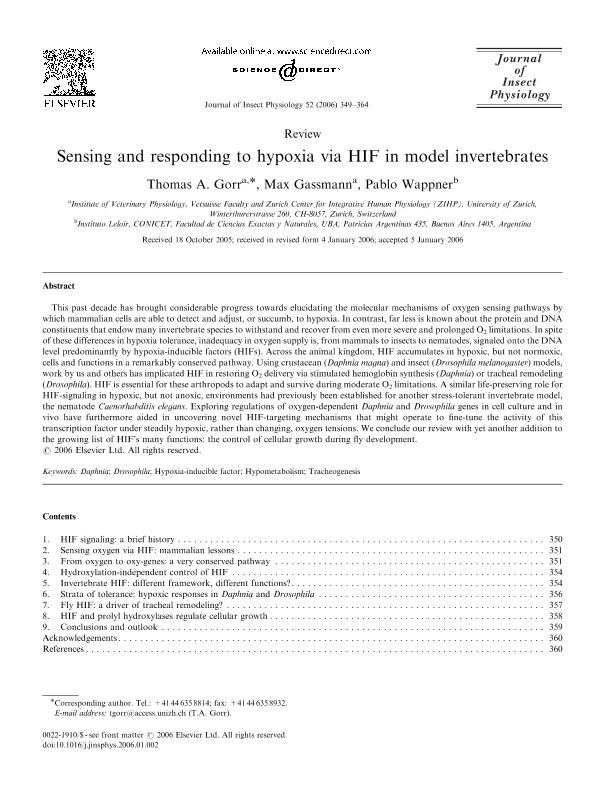Mostrar el registro sencillo del ítem
dc.contributor.author
Gorr, Thomas A.
dc.contributor.author
Gassmann, Max
dc.contributor.author
Wappner, Pablo

dc.date.available
2018-03-16T13:31:12Z
dc.date.issued
2006-04
dc.identifier.citation
Gorr, Thomas A.; Gassmann, Max; Wappner, Pablo; Sensing and responding to hypoxia via HIF in model invertebrates; Pergamon-Elsevier Science Ltd; Journal of Insect Physiology; 52; 4; 4-2006; 349-364
dc.identifier.issn
0022-1910
dc.identifier.uri
http://hdl.handle.net/11336/39062
dc.description.abstract
This past decade has brought considerable progress towards elucidating the molecular mechanisms of oxygen sensing pathways by which mammalian cells are able to detect and adjust, or succumb, to hypoxia. In contrast, far less is known about the protein and DNA constituents that endow many invertebrate species to withstand and recover from even more severe and prolonged O2 limitations. In spite of these differences in hypoxia tolerance, inadequacy in oxygen supply is, from mammals to insects to nematodes, signaled onto the DNA level predominantly by hypoxia-inducible factors (HIFs). Across the animal kingdom, HIF accumulates in hypoxic, but not normoxic, cells and functions in a remarkably conserved pathway. Using crustacean (Daphnia magna) and insect (Drosophila melanogaster) models, work by us and others has implicated HIF in restoring O2 delivery via stimulated hemoglobin synthesis (Daphnia) or tracheal remodeling (Drosophila). HIF is essential for these arthropods to adapt and survive during moderate O2 limitations. A similar life-preserving role for HIF-signaling in hypoxic, but not anoxic, environments had previously been established for another stress-tolerant invertebrate model, the nematode Caenorhabditis elegans. Exploring regulations of oxygen-dependent Daphnia and Drosophila genes in cell culture and in vivo have furthermore aided in uncovering novel HIF-targeting mechanisms that might operate to fine-tune the activity of this transcription factor under steadily hypoxic, rather than changing, oxygen tensions. We conclude our review with yet another addition to the growing list of HIF's many functions: the control of cellular growth during fly development. © 2006 Elsevier Ltd. All rights reserved.
dc.format
application/pdf
dc.language.iso
eng
dc.publisher
Pergamon-Elsevier Science Ltd

dc.rights
info:eu-repo/semantics/openAccess
dc.rights.uri
https://creativecommons.org/licenses/by-nc-sa/2.5/ar/
dc.subject
Daphnia
dc.subject
Drosophila
dc.subject
Hypometabolism
dc.subject
Hypoxia-Inducible Factor
dc.subject
Tracheogenesis
dc.subject.classification
Otras Ciencias Biológicas

dc.subject.classification
Ciencias Biológicas

dc.subject.classification
CIENCIAS NATURALES Y EXACTAS

dc.title
Sensing and responding to hypoxia via HIF in model invertebrates
dc.type
info:eu-repo/semantics/article
dc.type
info:ar-repo/semantics/artículo
dc.type
info:eu-repo/semantics/publishedVersion
dc.date.updated
2018-03-15T15:21:50Z
dc.identifier.eissn
1879-1611
dc.journal.volume
52
dc.journal.number
4
dc.journal.pagination
349-364
dc.journal.pais
Reino Unido

dc.journal.ciudad
London
dc.description.fil
Fil: Gorr, Thomas A.. Universitat Zurich; Suiza
dc.description.fil
Fil: Gassmann, Max. Universitat Zurich; Suiza
dc.description.fil
Fil: Wappner, Pablo. Consejo Nacional de Investigaciones Científicas y Técnicas. Oficina de Coordinación Administrativa Parque Centenario. Instituto de Investigaciones Bioquímicas de Buenos Aires. Fundación Instituto Leloir. Instituto de Investigaciones Bioquímicas de Buenos Aires; Argentina. Consejo Nacional de Investigaciones Científicas y Técnicas. Oficina de Coordinación Administrativa Ciudad Universitaria. Instituto de Química Biológica de la Facultad de Ciencias Exactas y Naturales. Universidad de Buenos Aires. Facultad de Ciencias Exactas y Naturales. Instituto de Química Biológica de la Facultad de Ciencias Exactas y Naturales; Argentina
dc.journal.title
Journal of Insect Physiology

dc.relation.alternativeid
info:eu-repo/semantics/altIdentifier/url/https://www.sciencedirect.com/science/article/pii/S0022191006000060
dc.relation.alternativeid
info:eu-repo/semantics/altIdentifier/doi/http://dx.doi.org/10.1016/j.jinsphys.2006.01.002
Archivos asociados
